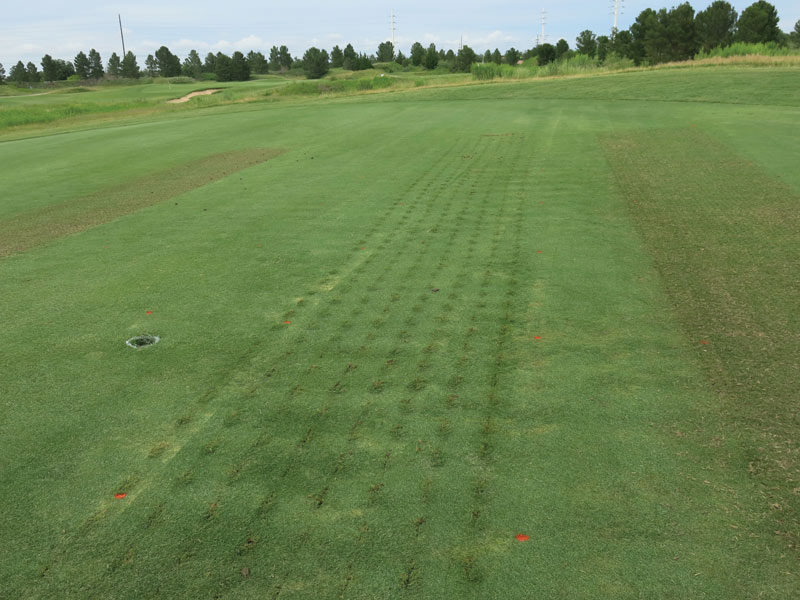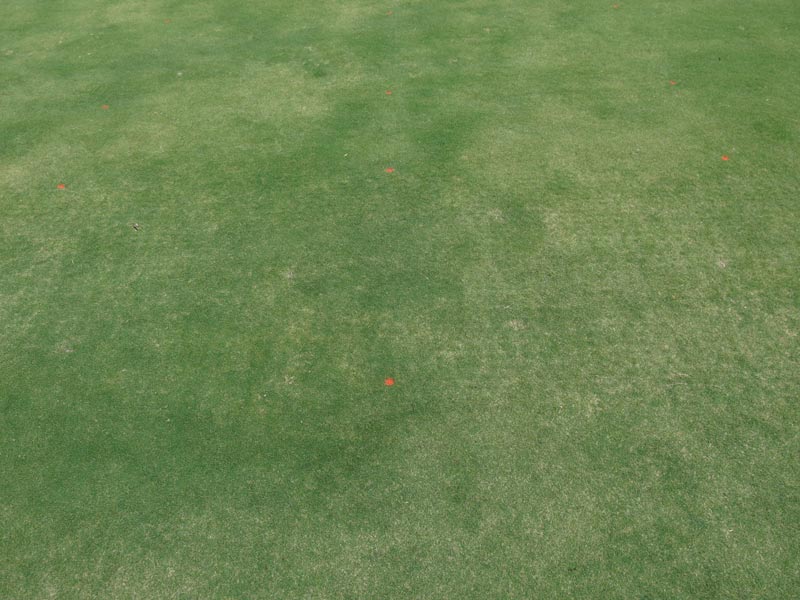
Golf courses in the area around Lubbock, Texas, irrigate with groundwater from the Ogallala Aquifer, but water depletion has reduced water quality in some areas. This photo shows the study site at Meadowbrook Golf Course in Lubbock as it appeared in October 2015. Photos by Joseph Young
Editor’s note: This research was funded in part by a grant to GCSAA from the Environmental Institute for Golf.
Use of alternative water resources in golf course management continues to expand as demand for potable water increases in urban areas. These alternative water resources tend to contain higher salt, sodium or contaminants that affect the growth and health of turfgrasses.
Golf courses on the Southern High Plains of Texas irrigate with groundwater from the Ogallala Aquifer. Water quality in this southernmost portion of the aquifer has diminished with extensive water depletion and minimal recharge. Although the quality of this groundwater source may be better than the quality of the water used in other locations, high salinity and bicarbonates raise concerns for golf course superintendents throughout this region.
Gypsum is commonly applied to turfgrasses irrigated with poor-quality water to maintain adequate soil structure and facilitate sodium displacement from cation exchange sites. Chemical manufacturers have developed more-soluble formulations of gypsum that are thought to improve effectiveness and speed of activity for turfgrass uses.
Best management practices for reducing soil salinity include frequent cultivation practices and application of leaching fractions of irrigation (1-4). The semiarid climate of the Southern High Plains does not consistently provide adequate rainfall to effectively leach salts. Moreover, the region experiences frequent droughts and high evapotranspiration losses that increase water demand. Combining these climate conditions with turfgrass water demand in the region has increased the importance of water conservation strategies. Therefore, applying the additional irrigation required to leach salts is in direct opposition to these conservation strategies.
Soil surfactants improve water infiltration, dispersion and holding capacity to improve turfgrass performance and playability with reduced irrigation (5). Enhancing these water-movement properties may assist in improving leaching effectiveness during rainfall, or provide greater leaching capabilities without the need for additional water. This belief had not been tested experimentally, so the objectives of this study were to determine whether cultivation practices (core aerification or slicing) combined with commercial products (gypsum-based products or soil surfactants) could reduce soil salinity without the application of leaching fractions of irrigation.
Methods
This study was conducted in 2015 and 2016 at two golf courses in Lubbock, Texas: The Rawls Course, which has TifSport hybrid bermudagrass (Cynodon dactylon × C. transvaalensis), and Meadowbrook Golf Course, which has common bermudagrass (C. dactylon). A single fairway at each location was selected, and a randomized complete block experiment was established with strip-split plot treatment arrangement and three replications.
Cultivation practices were applied in June 2015 and 2016 within larger strips. Core aerification was applied with a Toro ProCore 648 with ¾-inch-diameter (2-centimeter-diameter) tines to a 3-inch (7.6-centimeter) depth on 2-inch × 2-inch (5-centimeter × 5-centimeter) spacing to affect 11% of the surface. An Aerway slicer was included as a solid-tine-like cultivation that would not require cleanup or disrupt play, and another strip, an untreated control, was not cultivated.

A non-cultivated control and two cultivation practices — core aerification and slicing — were applied at both golf courses. The Rawls Course is shown here.

Granular products were weighed precisely for plot area and spread by hand with a glass shaker jar.
Within each cultivated strip treatment, gypsum-based products or soil surfactants were applied in small plots (6 feet × 5 feet; 1.8 meters × 1.5 meters) (Table 1). Granular products were weighed precisely for plot area and spread with a glass shaker, and liquid surfactants were applied with a CO2-powered backpack sprayer at 2 gallons of water/1,000 square feet (81.49 milliliters/square meter).
Soil samples were collected in June, August and October of 2015 and 2016 to determine soil pH and electrical conductivity (EC). Three profile samples to a 4-inch (10-centimeter) depth were obtained from each plot and mixed after removing turf canopy for soil analysis. Volumetric water content (TDR 300, Spectrum Technologies), visual turf quality (1 to 9 scale, where 9 = best, 1 = worst and 6 = acceptable), and spectral analyses (TurfScout TCM 500 NDVI meter, Spectrum Technologies; RapidSCAN CS-45, Holland Scientific) assisted with measuring the playability and health of bermudagrass at each location.
Results
Water-quality test reports from both golf courses indicated high salt content but limited sodium permeability hazards because of high calcium and magnesium (Table 2). Soil EC levels in the top 4 inches of the root zone fluctuated with rainfall events that provided natural leaching of salts. However, no cultivation practice or product reduced soil EC compared with the untreated control.
Granular gypsum-based products increased soil EC in August 2015 at both golf courses. In this instance, soil samples were obtained a couple of weeks after product application, which would be expected to increase salinity. No other differences in soil EC were observed on The Rawls Course fairway, but granular gypsum-based products had higher soil EC than untreated controls at Meadowbrook Golf Course on all soil sampling dates (Figure 1). Gypsum-based granular products positively affected soil pH at the conclusion of the research, with those treatments having lower pH than the untreated control and many surfactant-treated plots (Figure 2). This suggests consistent application of gypsum over a long period of time can reduce soil pH, but it is important to note that consistent application of those granular products resulted in a small incremental reduction of soil pH.
Cultivation practices did not reduce soil salinity in the upper 4 inches of soil at any point in the two-year experiment, but slight soil texture differences at the two golf courses affected recovery from cultivation practices. The fairway at The Rawls Course contained approximately 5% more clay than Meadowbrook Golf Course. This increased clay content did not allow the soil to collapse back into aerification holes, which slowed recovery following core aerification. The reduced recovery from aerification resulted in poor visual turf quality, normalized difference vegetation index (NDVI) and ratio vegetation index (RVI). Ratio vegetation index provided an objective measure of plant health and cover that was obtained more frequently, and these data were similar to visual turf quality and NDVI.

Aerification scars were still visible on the study site at The Rawls Course in early October 2015, more than three months after aerifying.
Both golf course fairways experienced reduced RVI immediately following core aerification, as expected from injury (Figure 3). However, The Rawls Course continued to have lower RVI throughout summer months because of limited soil collapse and recovery. In contrast, Meadowbrook Golf Course had higher RVI in core-aerified or sliced treatments when compared to non-cultivated controls following initial recovery (Figure 3).
Soil texture and cultivation also altered water-retention characteristics and volumetric water content of the upper 1.5-inch (3.8-centimeter) soil depth. Further analysis on soil-moisture-retention properties is warranted between golf courses and surfactants, but laboratory procedures confirmed little concern of sodium permeability hazard affecting soil structure. The higher clay content at The Rawls Course fairway resulted in greater water holding near the surface regardless of cultivation treatment, but increased gravitational water movement at Meadowbrook Golf Course differentiated cultivation treatments when measuring volumetric water content in the upper 1.5 inches of soil. Core aerification created larger macropore space to increase surface drainage of water, reducing volumetric water content when compared to sliced or non-cultivated control treatments (Table 3). These effects were not significantly different among cultivation practices as frequently when volumetric water content was measured to the 3-inch depth.
Conclusions
No cultivation practice or product combination was effective at moving salts without applying leaching fractions of irrigation. Intense rainfall events were highly effective at reducing soil EC in the upper 4 inches, but untreated control treatments were reduced just as much as treated plots following rainfall events. Soil EC increased rapidly during summer months when rainfall was negligible, and greater reliance on supplemental irrigation was needed to support turfgrass growth in fairways.
The higher clay content at The Rawls Course (20%) when compared with Meadowbrook Golf Course (15%) likely slowed recovery from core aerification and reduced visual aesthetics of the fairway. However, both cultivation treatments increased visual aesthetics at Meadowbrook following recovery from initial injury.
More research is needed to evaluate mechanisms of salt movement in golf course fairways without requiring leaching fractions of water. Bermudagrass at both of these locations never appeared to exhibit visible salt stress symptoms, so this may demonstrate the importance of selecting turfgrass species/cultivars capable of withstanding salinity stress as a means of minimizing the need for frequent leaching irrigation.
Funding
The authors would like to thank GCSAA, the Environmental Institute for Golf and the United States Golf Association for funding this research.
Acknowledgments
The authors thank the golf course superintendents at The Rawls Course and Meadowbrook Golf Course for allowing us to conduct this research at their facilities.
This research was originally published as “Effects of cultivation practices and products on bermudagrass fairways in a semiarid region” by L. Li, J. Young and S. Deb. 2019. Agronomy Journal 111:1-11. doi:10.2134/agronj2019.04.0262. Mr. Li completed his M.S. degree requirements at Texas Tech in May 2017.
The research says ...
- No cultivation practice or product reduced soil EC without leaching irrigation.
- Gypsum-based products increased soil EC, but decreased pH following two years of applications.
- Soil with higher clay content slowed bermudagrass recovery from core aerification.
- Core aerification aided surface water movement in soil with higher sand content.
Literature cited
- Carrow, R.N., and R.R. Duncan. 2012. Best management practices for saline and sodic turfgrass soils: Assessment and reclamation. CRC Press Taylor & Francis Group, Boca Raton, Fla.
- Duncan, R.R, R.N. Carrow and M.T. Huck. 2009. Turfgrass and landscape irrigation water quality: Assessment and management. CRC Press Taylor & Francis Group, Boca Raton, Fla.
- Marcum, K.B. 2006. Use of saline and non-potable water in the turfgrass industry: Constraints and developments. Agricultural Water Management 80:132-146.
- Qian, Y.L., and B. Mecham. 2005. Long-term effects of recycled wastewater irrigation on soil chemical properties on golf course fairways. Agronomy Journal 97:717-721.
- Zontek, S.J, and S.J. Kostka. 2012. Understanding the different wetting agent chemistries. USGA Green Section Record 50:1-6.
Joseph Young is an assistant professor in the Department of Plant and Soil Science at Texas Tech University, Lubbock, Texas.